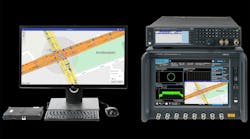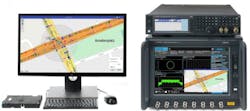C-V2X System Expands Test Solutions Across Automotive Workflow
What you'll learn:
- The types of testing supported by Keysight's new C-V2X system.
- Benefits of the system's environmental emulator, which allows for in-lab testing.
The biggest challenge in cars with advanced driver-assistance systems (ADAS) is the massive amounts of data from an increased number of sensors that decision-making units must process, in turn driving greater complexity in development, simulation, and testing.
Going to the next step—achieving the goal of fully autonomous driving—involves the development of still more complex software infused with artificial intelligence (AI). It ultimately must correctly interpret and act upon streams of real-time data from the surrounding infrastructure as well as from the arrays of in-vehicle-based sensors. Thorough verification of the functionality, performance, and safety of such systems will depend on detailed simulation and testing in the lab.
Cellular vehicle-to-everything (C-V2X) communications allows automobiles to directly connect with each other, roadside infrastructure, and pedestrians. Its benefits range from road safety, traffic efficiency, and smart mobility to environmental sustainability and driver convenience.
Keysight Technologies recently introduced a test solution that’s able to stay in step with evolving C-V2X requirements. The SA8700A supports RF, protocol, and application-layer testing, as well as providing support for future releases of 5G New Radio (NR) C-V2X. This will help accelerate deployment of the technologies developed for advanced AV capabilities.
The foundation is the Keysight UXM 5G wireless test set coupled with the C-V2X test application (C8732114A), a suite of Keysight X-Apps C-V2X RF measurements (C87320R1A), C-V2X waveform generation (C87320R2A), an intelligent transportation system (ITS) stack, and application-layer testing. The C-V2X solution leverages the same X-Apps and same measurement algorithms used in Keysight’s signal analyzers and wireless test sets.
Supporting 3GPP Release 15, the wireless test solution enables engineers to establish a 5G call with a device under test (DUT) in different 5G NR deployment modes—non-standalone (NSA), standalone (SA), and frequency bands FR1 and FR2. The solution performs signaling test for device RF characteristics, protocol compliance, and functional key performance indicators.
The test system facilitates validating DUT performance over-the-air (OTA) with chambers designed for different test cases across the device workflow.
Keysight's C-V2X Autonomous Drive Emulation (ADE) solution on the UXM 5G Wireless Test platform supports a range of test types that will support future releases of 5G NR C-V2X, including:
- Transmitter testing: Power, error-vector magnitude (EVM, a measure used to quantify the performance of a digital radio transmitter or receiver; a signal sent by an ideal transmitter or received by a receiver would have all points precisely at the ideal locations), frequency accuracy, in-band emissions, and adjacent channel leakage ratio (ACLR is the ratio of the transmitted power on the assigned channel to the power received in the adjacent radio channel).
- Receiver testing: Sensitivity, maximum input level, adjacent-channel selectivity.
- Protocol testing: Ensure correct PC5 link protocol, V2X message types and content are sent and received. Coverage of C-V2X and LTE protocol test cases for GCF (Global Certification Forum, often required by operators in countries outside of North America for network access and connectivity to devices) and PTCRB device certification (PCS Type Certification Review Board, a pre-requisite for carriers such as AT&T, T-Mobile, etc., regarding network testing).
- Application-layer testing: Incorporate application-level testing that integrates C-V2X scenarios with hardware-in-the-loop (HIL) systems.
The C-V2X ADE solution provides an environment emulator for in-lab testing versus realistic roadway scenarios. Using total scene generation, it exercises ADAS software using time-synchronized inputs to the actual sensors, enabling engineers to:
- Validate the system performance earlier in the development cycle and enhance validation with synchronous testing of communication-based systems with application-level testing that integrates C-V2X scenarios with HIL systems.
- Leverage the flexibility of the platform to add relevant sensor types and expand as sensor systems and test requirements evolve.
- Reduce integration costs by leveraging an existing test environment and workflow.
- Verify performance relative to the relevant ITS stack, ensuring accurate communication to and from the vehicle, covering cases for all major regions: China, Europe, and the United States.
- Use 24/7 regression testing to ensure the quality of future updates as well as consistent testing of features and updates that are released post-start of production.

